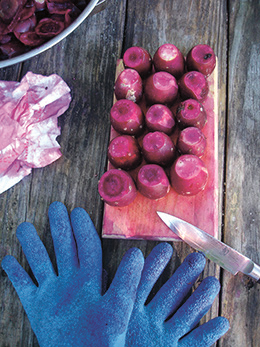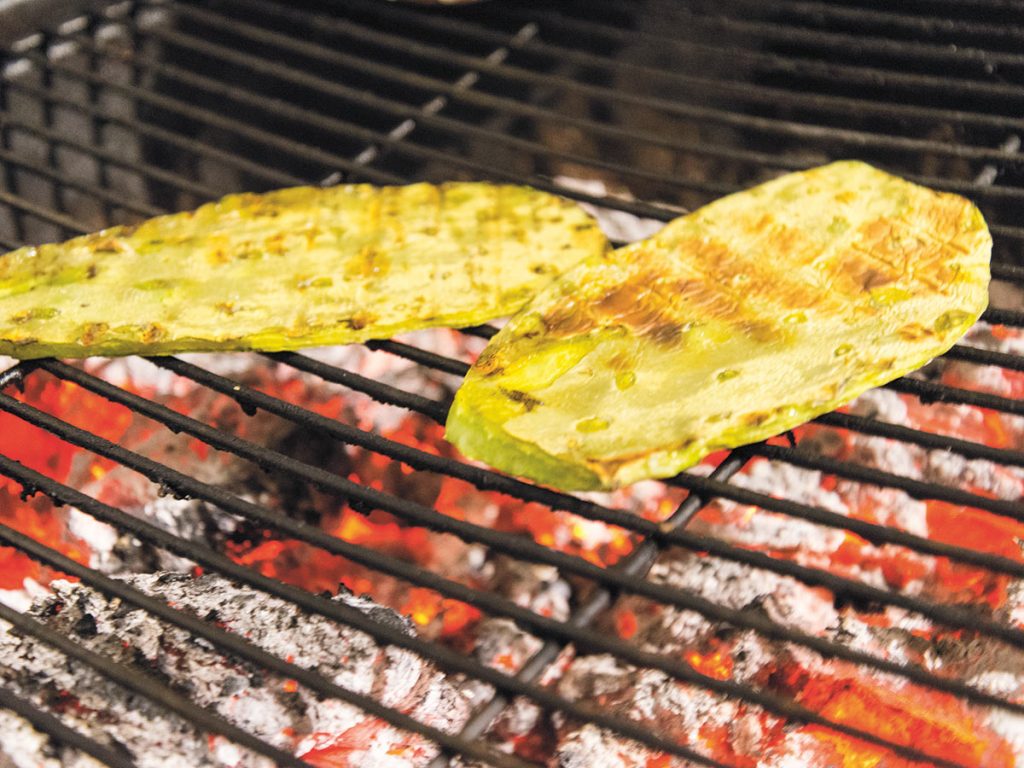Don’t Fear the Reaping
The prickly pear’s uses are as multitudinous as its names and varieties. The flowers, pears (tuna) and pads (nopales) are all edible. While the generous plant provides a food source for humans as well as forage for wildlife, its functions reach beyond the comestible: It serves as a traditional border to cattle ranges; yard ornament for gardeners; crucial nectar source for native bees; and coveted natural dye source, both as magenta juice from the fruit and from powdered cochineal, a scale insect that dwells on the plant and is responsible for the rich red hue known as carmine. Any attempt to narrow its boundless uses as a garden feature and a foraged food still leaves much utility unexplored, making the prickly pear a desirable addition to the locavore and landscaper’s palette alike.
While there are a wide variety of species with different colored flowers as well as various shapes and sizes of plants, the most common to the kitchen is called the Indian fig opuntia (Opuntia ficus-indica), which is thought to be native to Mexico. Native Texas species include Texas prickly pear (O. engelmannii var. lindheimeri), the less-common cow’s tongue cactus (O. engelmannii var. linguiformis), bigroot prickly pear (O. macrorhiza), cactus apple (O. engelmannii var. engelmannii) and low prickly pear (O. humifusa), a smaller, more prostrate plant. Prickly pears are prone to cross-pollination and other means of intermingling, sometimes making the particular type difficult to discern.
Prickly pears can be confined to a pot, given proper drainage and appropriate sun, or allowed to flourish en masse as a major component of xeriscape gardens. These hardy cacti thrive in Texas Blackland Prairies and can handle tough soils like clay-heavy Houston “gumbo” (which, though high in organic matter, is hard for water to permeate) and limestone-rich caliche. Their versatility, benefits to fauna and wide range of colors — from the brilliant purple of ripe tunas and bright green of new growth to blossoms of citrusy lemon yellow and grapefruit pink — are all excellent reasons to plant your own. If collecting pads (a type of flattened stem known as a cladophyll) from the wild, consider rooting a smaller one in your garden to propagate a new plant; take note of that plant’s particular terrestrial situation and match it as closely as you can.
In culinary terms, the cleanest way to harvest prickly pear paddles, tunas and flowers (which can be eaten raw in salads) is from your own yard. That way, you can ensure the safety of the fertilizer and the soil in which it grows. If foraging, find a patch far removed from traffic to avoid pollution from roadside runoff. It’s always best to find the property owner and request access: The removal of a plant from private, public or state property can be viewed as theft and fined as such, especially if the plant is rare or protected. However, prickly pear happens to thrive on more than 30 million acres of rangelands in the western two-thirds of Texas, according to the Texas A&M AgriLife Extension, and the plant is considered a pest in the Edwards Plateau (among other areas). As such, there are probably plenty of landowners who wouldn’t mind lending a few pears — its removal might even be appreciated.

Gloves and a sharp knife are essential tools when peeling tunas; when ripe, the outer flesh slips off easily. PHOTO Amy McCullough
When harvesting, be mindful that, in addition to visible long spines, these plants (even the “spineless” species, O. ellisiana) have self-preserving hair-fine spines, known as glochids, all over them and must be treated with care and ingenuity, else your hands and tongue will suffer. One safe method requires an empty single-serving plastic soda bottle, with its neck cut off, as well as a pair of thick leather gloves, tongs, a disposable but clean cardboard box and a pocket or paring knife. Donning the gloves, place the open end of the plastic bottle over the fruit, gently pinching it around the tuna and thus holding it still as you cut; it is okay to take a small amount of the paddle beneath. Looking into the flesh of the pear itself is the only way to ensure ripeness, but they should be ready in late summer when the flesh begins to turn dark purple. Be mindful of brown or rotten spots. The fruit should smell sweet and look something like a ripe watermelon inside.
Paddles are available for use year-round, but you want them on the smaller, greener side. Tender spring growth is sweeter and preferred in the kitchen (a paddle that’s around 4 inches wide and 5 inches tall is ideal). Use tongs to grip individual paddles as you slice them from the plant with a knife. Cutting, rather than tearing or ripping pieces, allows for faster regeneration of the plant. Remember to always keep your tools clean; it’s wise to take caution and prevent spreading disease.
Once home with your bounty, use tongs to hold individual paddles and pears over a flame (barbecue, gas burner or culinary torch). This burns off the offending spines, allowing for peeling or other required prep (parboiling is another option). Continue to wear gloves and use clean tongs to hold tunas as you slice down their sides and peel the outer skin off (much like you would an onion). On paddles, pare any bumps where prickles grew, leaving the majority of the skin intact.

Burning paddles is one way to remove spines and glochids; during drought or deep winter, cowboys sometimes burn the plant to allow cattle to forage on it. PHOTO Esdelval/iStock
Now that you’ve harvested your paddles and pears, the culinary uses are endless: Paddles serve as an alternative to peppers in nopales rellenos, as a fried side dish, in sautéed salads, and as an additive to eggs in breakfast tacos and scrambles. Tunas will yield about one cup syrup per pound of fruit; the syrup can be used in jams, jellies and as a tangy sweetener for exotic cocktails ranging from margaritas to a gin fizz. Below you’ll find two innovative (and complementary) recipes to get you started with this gardening and gastronomic delight.

1 ounce dry gin
1/2 ounce prickly pear syrup*
1 teaspoon sugar in the raw
Lemon basil
Prosecco
Twist of lemon peel
Chili powder
Stir sugar and chili power together in a shallow, flat-bottomed plate. Dip the rim of a coupe glass into prickly pear syrup and then chili-sugar mixture to coat. Muddle gin, syrup, sugar and lemon basil in a shaker or pint glass. Shake to chill and finely strain into glass to remove sediment from syrup and basil. Top off with prosecco and twist of lemon peel so that the lemon oil and peel sit atop the drink.
*PRICKLY PEAR SYRUP
3 parts tuna
1/2 part jalapeño (optional)
1 part honey or agave to sweeten
Zest and juice of 1 lemon per cup of
puréed tuna
Prepare tunas by burning off glochids, rinsing, peeling and pureeing the flesh. (At this point, you can freeze the pureed fruit in ice cube trays for later use.) Add jalapeños to blender or food processor and blend. If you desire, strain puree through fine metal strainer or cheese cloth. Measure resulting puree, then add to sauce pan along with agave or honey and lemon juice and rind in ratio to tuna puree. Bring to simmer and stir, never allowing to boil. There may be “scummy” foam that rises to top; skim and continue simmering until desired thickness. Either freeze or refrigerate; use within two weeks if the latter.

This recipe is made in two parts: the batter and the fries. While the batter is whipping, clean and blanch the paddles by dropping them into boiling water for 15 seconds, then into an ice bath. The blanching reduces any potential sliminess, similar to okra. (Don’t let that keep you from trying nopales!) When you cut the paddle (nopal) into smaller pieces, it becomes “nopalitos,” which is how you’ll find them referenced in restaurants and this recipe.
3 young paddles, cleaned, blanched and sliced 1/4-inch thick
4 large eggs, separated
2 tablespoons corn starch
Seasoning mix*
All-purpose flour
Flavorless oil, such as soy or canola
Thick-walled, deep frying pan or Dutch oven
Oil thermometer
*SEASONING MIX
1 teaspoon sea salt
1 teaspoon black pepper
1 teaspoon cumin
1 teaspoon chili powder
1/4 teaspoon smoked paprika
1/4 teaspoon oregano
1/8 teaspoon garlic powder
1/8 teaspoon onion powder
Beat separated egg whites with corn starch with a mixer until stiff white peaks are formed.
Heat three inches of oil in your pan until it reaches 375 degrees Fahrenheit. While the oil heats, sprinkle nopalitos through seasoning, then all-purpose flour. Separate on racks or by layering strips between sheets of parchment paper.
When the oil is hot, dip dredged nopalitos in the egg batter and fry in batches. Add pieces to the oil slowly to keep strips from sticking together and to prevent splashing. Use a wire spider to move the fries around in the oil — keep in mind that the temperature of the oil
will drop as strips are added; return heat to 375 F after each batch, adding oil if necessary. Fries will take 5 to 7 minutes to cook; batter
should turn golden brown and crispy. Remove fries to paper towels or cooling racks, keeping separated; repeat process until finished. Sprinkle with extra seasoning for presentation and to taste.

